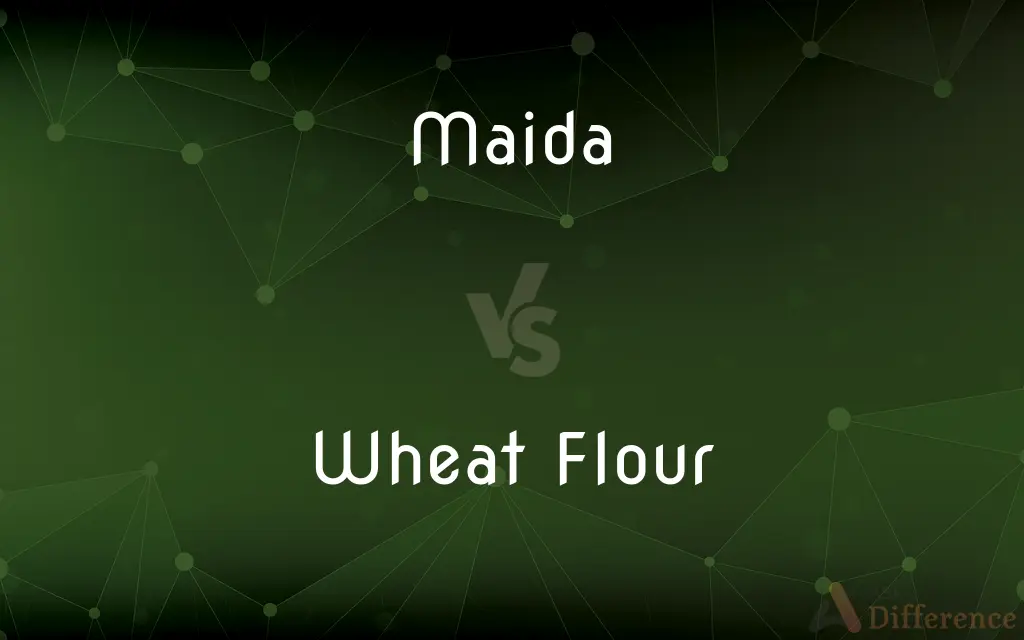Maida vs. Wheat Flour — What's the Difference?
By Tayyaba Rehman — Published on January 23, 2024
Maida is a finely milled, refined, and bleached wheat flour used in South Asian cuisine; Wheat flour is less processed, containing more fiber and nutrients.

Difference Between Maida and Wheat Flour
Table of Contents
ADVERTISEMENT
Key Differences
Maida, commonly used in South Asian cooking, is a white flour made from wheat that has been heavily refined and bleached. It is known for its fine texture and light color. In contrast, wheat flour, often referred to as whole wheat flour, is made from the entire wheat grain, including the bran, germ, and endosperm, resulting in a coarser texture and a more nutritious profile.
The refining process of maida removes most of the fiber and nutrients found in wheat, leaving behind mostly starch. This gives maida a softer texture and a longer shelf life but reduces its nutritional value. Wheat flour retains its natural vitamins, minerals, and fiber, making it a healthier choice with a shorter shelf life.
In cooking, maida is preferred for its ability to create lighter, fluffier baked goods and is often used for pastries, bread, and some types of noodles. Wheat flour, with its higher fiber content, is denser and heavier, making it suitable for heartier bread, rotis, and other baked goods where a robust texture is desired.
Maida's low fiber content means it has a higher glycemic index compared to wheat flour, which can impact blood sugar levels. People with dietary restrictions or those seeking a healthier option often opt for wheat flour due to its whole grain benefits.
In terms of availability, maida is widely used and available in South Asia, while wheat flour is commonly found in many parts of the world, reflecting different dietary habits and preferences in cooking and baking.
ADVERTISEMENT
Comparison Chart
Processing
Highly refined and bleached
Less processed, whole grain
Nutritional Content
Lower in fiber and nutrients
Higher in fiber, vitamins, and minerals
Texture in Cooking
Lighter and finer texture
Heavier and coarser texture
Health Impact
Higher glycemic index
Lower glycemic index, more health benefits
Common Uses
Pastries, bread, noodles
Hearty bread, rotis, whole grain baked goods
Compare with Definitions
Maida
Maida is known for its soft and fine texture.
The cake was soft because it was made with maida.
Wheat Flour
Wheat flour is denser and heavier than maida.
Whole wheat rotis are more filling than those made with maida.
Maida
Maida is commonly used in South Asian cuisine.
For making naan bread, maida is often preferred.
Wheat Flour
Wheat flour retains the bran, germ, and endosperm of the wheat.
Wheat flour is healthier due to its whole grain content.
Maida
Maida lacks the fiber and nutrients of whole wheat.
While maida is great for pastries, it's not as nutritious as whole wheat flour.
Wheat Flour
Wheat flour is a nutritious alternative to refined flours.
I use wheat flour for baking to increase my dietary fiber intake.
Maida
Maida is a finely milled, refined white wheat flour.
I used maida to make the dough for samosas.
Wheat Flour
Wheat flour is commonly used in hearty and robust baked goods.
For a healthier pizza crust, I prefer using wheat flour.
Maida
Maida is a popular choice for refined flour dishes.
Maida is essential for traditional Indian sweets like jalebi.
Wheat Flour
Wheat flour is made from the whole grain of wheat.
Wheat flour adds a nutty flavor to bread.
Maida
A finely milled, refined and bleached wheat flour, used in making many Indian foods like samosa, chakli and bhatoora.
Common Curiosities
What is maida?
A refined and bleached wheat flour.
What is wheat flour used for?
For making healthier, fiber-rich bread and baked goods.
Is wheat flour good for diabetes?
Better than maida, due to its lower glycemic index.
Why is maida preferred in cakes?
For its fine texture and lightness.
Is maida nutritionally rich?
No, it's lower in nutrients compared to whole wheat flour.
Can maida be used for bread?
Yes, but it results in softer, less nutritious bread.
Is maida good for health?
It's less healthy due to low fiber and nutrient content.
Can I substitute wheat flour for maida?
Yes, but it changes the texture and nutritional profile of dishes.
Is maida or wheat flour better for weight loss?
Wheat flour, due to higher fiber content.
Is wheat flour better for digestion?
Yes, due to its higher fiber content.
Is wheat flour gluten-free?
No, it contains gluten.
Does maida have a longer shelf life than wheat flour?
Yes, due to the removal of oils and bran.
Can maida be used for frying?
Yes, it's often used for batters in frying.
Is wheat flour more expensive than maida?
It can be, depending on the brand and quality.
Which is better for traditional Indian sweets, maida or wheat flour?
Maida is traditionally used for many Indian sweets.
Share Your Discovery

Previous Comparison
GED vs. High School Diploma
Next Comparison
ISBN vs. ISSNAuthor Spotlight
Written by
Tayyaba RehmanTayyaba Rehman is a distinguished writer, currently serving as a primary contributor to askdifference.com. As a researcher in semantics and etymology, Tayyaba's passion for the complexity of languages and their distinctions has found a perfect home on the platform. Tayyaba delves into the intricacies of language, distinguishing between commonly confused words and phrases, thereby providing clarity for readers worldwide.













































